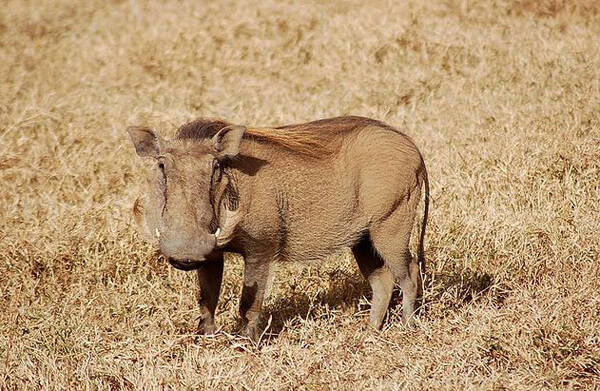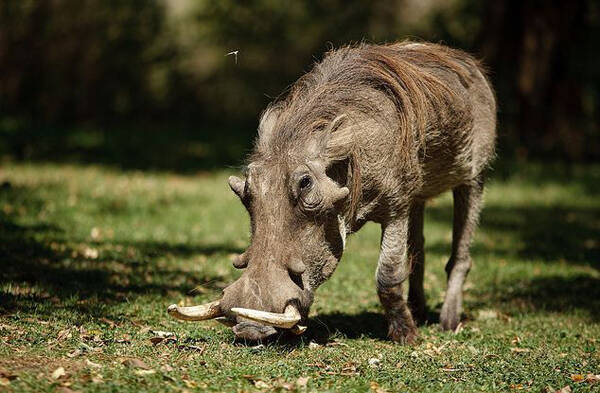Phacochoerus aethiopicus
IUCN
LCBasic Information
Scientific classification
- name:Phacochoerus aethiopicus
- Scientific Name:Phacochoerus aethiopicus,Desert Warthog,Desert warthog, Cape warthog, Somali warthog
- Outline:Ungulata
- Family:Artiodactyla Suidae Pterochoerus
Vital signs
- length:90-150cm
- Weight:50-150kg
- lifetime:About 12 years
Feature
High reproductive capacity, but high mortality rate of young
Distribution and Habitat
Distributed in Ethiopia, Kenya and Somalia. Southern Somalia, eastern Ethiopia (Ogaden) and eastern Kenya, from near sea level in central Kenya to about 1,400 meters. Although thought to be restricted to arid environments, its range in Kenya is found to extend southwards to Tsavo West National Park. These species also formerly lived in South Africa, in the southeastern part of the former Cape Province and adjacent areas of KwaZulu-Natal, but are now extinct.
Appearance
The Desert Warthog weighs 50-150 kg and is named for the pair of large warts that grow under each eye. Male warthogs have another pair of smaller warts on their snouts, above their tusks. These warts may help protect the eyes when digging for food. They also make the head look larger, giving the adult warthog a more ferocious appearance. The back is bristled. There are four long and sharp tusks. There is a long gray bristle on the back, and the head is seriously out of proportion to the body. The huge head accounts for about one-third of the body length and looks heavier than the body. In addition to the pointed warts that make the warthog look ferocious, the four huge tusks are even more intimidating. The upper tusks of male warthogs are large, 38-65 cm, and are sharply curved upward and outward. The short and pointed lower tusks can be used as knives.
The proportions of the skull are similar to those of the African warthog, but the skull and teeth are different. The zygomatic arch
Details
Desert Warthog (scientific name: Phacochoerus aethiopicus) has two subspecies.

Desert Warthogs seem to be most active during the day, even in the hottest weather. They spend the night in caves as a family unit. They raid crops seasonally in the valleys of southern Somalia. Warthogs are diurnal animals that return to their dug burrows at night to sleep. They have a keen sense of smell and hearing, but poor vision. When in distress, they make pig calls. Warthog families consist of an adult female and 5-10 young, usually 5. Males often live alone. They are good at digging holes, which can be used to avoid predators and protect them from the sun. Although they are very good at digging holes, they will use the burrows of other animals as their homes. They enter these holes with their hindquarters first, always facing the hole, so that they can use their tusks to fight intruders first. When they wake up every morning, they will rush out of their burrows at high speed to avoid any predators that may be waiting at the entrance. Aggressive. Feed on grasses, mosses and tubers, and occasionally eat carrion. Like mud baths. They have strong survival ability and are very adaptable to high temperature and drought environments. They can go without drinking water for several months.
After choosing a mate, the desert warthog will not look for another partner in the same breeding season. In rainy areas, they can breed all year round, and in drier areas, breeding is seasonal. Mating mainly occurs between May and June, and the peak period of piglet birth occurs in November and December. The number of piglets varies from 2 to 6, mainly 3 to 4. The age of the first birth is 2 years old, the interval between births is 12 months, and the female has a lifespan of 12 years. In most cases, the sex ratio of males to females is about 1.5:1. Piglets are born when the rainy season comes, and heavy rains bring abundant food. They have strong fertility. Due to the special shape of the reproductive organs, the end of the male pig's penis is spiral, which just matches the spiral canal of the female pig's cervix, so the sperm can enter the uterus directly. They have strong fertility, but the mortality rate of piglets is very high.

The desert warthog is vulnerable to extreme climate (including drought, high rainfall, low temperatures), disease (including rinderpest), and predation. The main threats are human-caused habitat degradation, loss and fragmentation, competition with livestock for water and food, and hunting by people (mainly non-Muslims). Limited drinking water and food appear to have limited population density in central Kenya (mean annual rainfall < 500 mm), and possibly elsewhere. A major increase in human and livestock numbers in central Kenya led to the species' decline and extinction. Competition for water and food increased as the region was severely overstocked with livestock both inside and outside official protected areas). The larger tusks of the desert warthog are traded as souvenirs in Somalia and are sometimes exported.
The desert warthog is found in at least 10 protected areas in Kenya (Meru National Park, Tsavo East National Park, Tsavo West National Park, Samburu Nature Reserve, Buffalo Springs Nature Reserve, Shaba Nature Reserve, Losi Nature Reserve, Arawale Nature Reserve, Dodori Nature Reserve, Boni Nature Reserve), at least one protected area in Somalia (Hargeisa National Park), and at least one protected area in Ethiopia, the Yabelo Wildlife Sanctuary.
Listed in the IUCN Red List of Threatened Species in 2015 ver 3.1 - Least Concern (LC).
Protect wild animals and eliminate game.
Maintaining ecological balance is everyone's responsibility!








